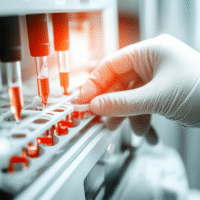Background
There are few effective treatments for older patients with acute myeloid leukemia (AML). A study was done to test a new treatment combining pegylated liposomal doxorubicin (PLD), low-dose cytarabine (LDAC), and granulocyte colony-stimulating factor (G-CSF) for elderly patients newly diagnosed with AML.
Study Details
Twenty-two patients were included in the study. The average age was 71.5 years, and most patients (72.7%) were over 70. The treatment involved one cycle to start and four cycles to consolidate, followed by maintenance therapy.
Results
The study showed promising results:
- Overall response rate: 77.3% (17 patients responded)
- Complete remission rate: 63.6% (14 patients achieved complete remission)
- Median overall survival: 15 months
- Median progression-free survival: 7.5 months
- Median duration of response: 11.9 months
However, some patients faced challenges, including:
- 57.1% relapsed after a median of 12.3 months
- Common serious side effects included febrile neutropenia (77.8%) and infections (63.6%), particularly pneumonia (45.5%).
- One patient died within 30 days of treatment (4.5%).
Conclusion
The combination of PLD, LDAC, and G-CSF is a well-tolerated option that offers high rates of remission and low early mortality for newly diagnosed older and unfit AML patients.
Next Steps
Define Measurable Outcomes
Set clear goals for treatment outcomes to track progress and effectiveness for clinics and patients.
Select AI Tools
Choose AI solutions that meet specific clinical needs to enhance treatment and management.
Implement Step by Step
Start with a pilot project, using AI to track results and assess the real-world impact of the treatment.
Contact Us for AI Solutions in Medical Management
For more information, reach out to us:





























